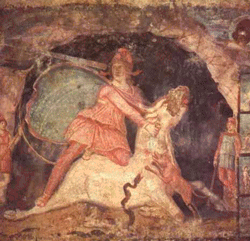 |
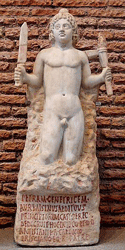 |
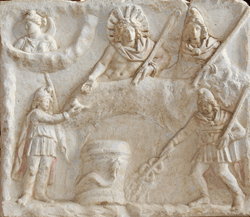 |
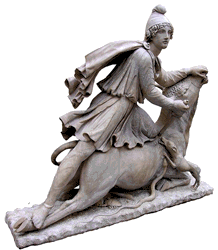 |
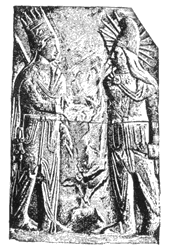 |
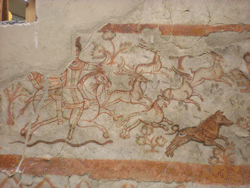 |
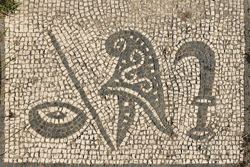 |
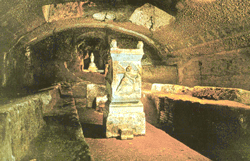 |
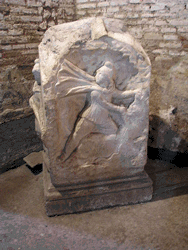 |
 |
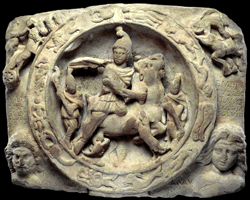 |
 |
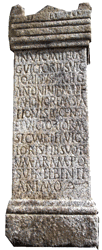 |
 |
 |
Posted on 08/30/2010 7:13:52 PM PDT by SunkenCiv
Foreign religions grew rapidly in the 1st-century A.D. Roman Empire, including worship of Jesus Christ, the Egyptian goddess Isis, and an eastern sun god, Mithras. Of the religions that expanded rapidly in the 1st-century Roman Empire, worship of Mithras was particularly popular among Roman soldiers, who spread his cult during their far-flung travels... Mithras's temples, called Mithraea, are the best archaeological evidence of the god's worship, and most of them featured a characteristic depiction of Mithras slaying a bull, a scene called the tauroctony... In the later Roman Empire, Mithras blended in with another sun god, Sol Invictus, the "unconquered sun." Both gods appeared in the Spanish provinces around the same time... Some 1st-century votive offerings in Rome even conflate the two gods into one deity, "Sol Invictus Mithras."
...The first mentions of "Mitra" come from India and Iran. The Rig Veda is a collection of sacred Sanskrit texts composed as early as 1200 B.C. Its Hymn 66 invokes "Mitra," a protector of the law and a god of light. In Iran, Mithras continued in the same vein: the modern Farsi word for "sun" is "mehr," also the root of "Mithras." The Greek historiographer Strabo (63 B.C.-A.D. 23) corroborates this report in Book XV of his Geography, noting that the Iranians "worship the sun also, whom they call Mithras." In Hymn 10 of the Yasht, an Iranian collection of praise poems to gods dating from after 250 B.C., Ahura Mazda, the god of light, commends Mithras. He tells his disciple, Zoroaster, that Mithras respects justice and brings "down terror upon the bodies of the men who lie...to [him]." ...Roman Mithras was a distant relative, not a direct descendant, of Indo-Iranian gods.
(Excerpt) Read more at archaeology.org ...
 |
 |
 |
 |
 |
 |
 |
 |
 |
 |
 |
 |
 |
 |
 |
|
|
|||
Gods |
Thanks Renfield! AFAIK, the Sarmatians brought the worship of Mithras into the Roman Empire, via their role as auxiliaries (cavalry) in the Roman army. |
||
|
· Discover · Bronze Age Forum · Science Daily · Science News · Eurekalert · PhysOrg · · Nat Geographic · Texas AM Anthro News · Yahoo Anthro & Archaeo · Google · · Archaeology · The Archaeology Channel · Excerpt, or Link only? · cgk's list of ping lists · · History topic · history keyword · archaeology keyword · paleontology keyword · · Science topic · science keyword · Books/Literature topic · pages keyword · · |
|||
Very interesting. Thanks.
Why were the Romans, so opposed to Christianity, so tolerant of Mithracism, which was from the arch-enemy Parthia?
Because early Christians were Jews, and the Romans had just destroyed the 2nd Temple in Jerusalem because of Jewish insurrection.
Because early Christians were Jews, and the Romans had just destroyed the 2nd Temple in Jerusalem because of Jewish insurrection.
Because early Christians were Jews, and the Romans had just destroyed the 2nd Temple in Jerusalem because of Jewish insurrection.
Because early Christians were Jews, and the Romans had just destroyed the 2nd Temple in Jerusalem because of Jewish insurrection.
Also because Christians were pacifists, Mithraism was popular with the legions.
Exactly. Jewish animosity was rampant in the 1st century. Over time traditional Christianity abandoned anything that even looked "jewish"...including the holy days of the Lord Jesus Christ, the Lords's sabbath, the food laws and other biblical practices.
“Why were the Romans, so opposed to Christianity, so tolerant of Mithracism, which was from the arch-enemy Parthia?”
Christianity forbids worship of any other God. The Christians would not worship Caesar.
The Romans I understand were very pluralistic, as long as you bowed the knee to Caesar.
We still struggle with the relationship between church and state.
I’m only gonna tell ya this four times, so...
/joke alert
It wasn’t from Parthia, IMO, there’s nothing exactly like Mithraism elsewhere, but the Romans apparently felt perfectly comfortable with wholesale acceptance of deities from conquered peoples, just as they got used to having the Roman Senate vote on deification of various emperors.
The Romans equated various members of their own pantheon with new introductions, as well as the Greek pantheon. Somewhat analogously, the Egyptians wound up with a deity called Serapis which was apparently the invention of one of the Ptolemaic pharaohs and/or his handlers.
Before the Romans, the Etruscans worshipped their version of Apollo, which they may have brought with them (the Etruscans came from the Aegean and Anatolia) or may have acquired (or reacquired) via their trade and cultural contacts with the Ionian Greeks. Apollo wasn’t a Greek deity, but borrowed from Anatolia, and his origin is another mystery. It would be more important, probably, if there were actually large numbers of worshippers of Apollo, Mithras, Zeus/Jupiter, etc etc.
There are some worshippers of the old Greek gods, oddly enough, they live in Hindu Kush, surrounded by Moslems. They claim descent from Alexander the Great’s soldiers, and are a cultural survival from antiquity. Quite amazing really.
I think you’re right. Probably an FR topic too.
Seeing how bull and sun worship were prevalent in the locale for a longish time, this seems like a new twist on the same old thing. Not being critical, just sayin’. I think it is interesting. I kinda dig Zoroaster myself. No bull.
You are correct. Some pantheistic Romans even has a statue of Christ, along with their other gods. But the Christians and Jews would not sacrifice a pinch of incense to Caesar, and were traitors. The Romans had grown up in contact with the Jews, so they left them alone, once they had destroyed their country.
I am amazed there are still practicers of Zoroaster in India.
Zoroaster gets on my nerves. He wears that black hat and mask, and pretends to write “z” on everyone he defeats using that flower he’s always carrying.
Probably because the Romans preferred turning the other guy’s cheek-with a Gladius.
It's amazing the things which have survived, and particularly in this case considering that this particular faith was not necessarily well thought of by the ancient Hindu.All Consuming FaithGriffon vultures are dying across India, apparently succumbing to a mysterious illness. Wildlife experts are becoming increasingly concerned about the viability of one species in particular. But for India's ancient Parsee religion the vultures' decline poses a more practical problem. Parsees, the religious descendants of the Zoroastrians of ancient Persia, rely on vultures to dispose of their dead, and the bodies are piling up.
by Debora MacKenzie
5 August 2000
New Scientist magazineEarliest Civilizations of the Near East"The people of Catal Huyuk buried their dead below the platforms of their houses and shrines only after the flesh had been removed, probably for the sake of hygiene. The primary process of excarnation may have taken place in light structures, built of reeds and matting as depicted on the wall of a shrine, or by means of vultures." [p 86]
by James Mellaart
1965, LOC 65-19415
Library of Early Civilizations
"In this book we see the first beginnings of agriculture from somewhere around 9000 BC, continuing in cultures in which at first pottery, long thought to be the main criterion of a 'neolithic' culture, was not in fact made, and then before many centuries have elapsed, the first use of metals -- copper or lead or gold, cold-worked from the native metal from the sixth millennium BC. The old technological-evolutionary stages of Mesolithic, Neolithic, Chalcolithic and so on are rapidly losing their crisp outlines, but only because we are now able to perceive something which, because it is more muddled and imprecise, is more human." [Stuart Piggott, general editor's preface]
Regarding their ancient scriptures, Mary Settegast wrote:Dancing with Siva:"Asceticism and celibacy are condemned; purity and avoidance of defilement... are valued... Zoroastrianism stresses monotheism, while recognizing the universal sway of two opposite forces... Man's life... is a moral struggle, not a search for knowledge or enlightenment. He is put on the earth to affirm and approve the world, not to deny it, not to escape from it... Man has but one life. He also has the freedom to choose between good and evil... At death, each is judged and consigned to his deserved abode... Though there is resurrection of the dead, a judgment and a kingdom of heaven on earth... all sins are eventually burned away and all of mankind exists forever with Ahura Mazda. Hell, for the Zoroastrian, is not eternal."
Hinduism's Contemporary Catechism
by Satguru Sivaya Subramuniyaswami
[pp 558-559, "Zoroastrianism"]
Luciano Canforra wrote:Plato PrehistorianPerhaps three-fourths of the original Zend-Avesta... is believed to be lost... The Avesta was not written down until the Sassanian period (the third to seventh centuries A.D.)... Zarathustra's Gathas are particularly obscure... Not only do the Gathas appear to be a good deal older linguistically than even the oldest parts of the Younger Avesta, but the same characters who speak and act with immediacy... are represented in the Younger Avesta as belonging to a remote past... The Fravardin Yast [of the Younger Avesta] ...contains references to Iranian peoples who were apparently unknown to the earliest Achaemenid records of the sixth century B.C. And with the single exception of "Ragha," believed to be ancient Rayy near Tehran, no allusion is made to a known Iranian city or village... A generic use of the prophet's name might also explain the occasional indications in ancient literature that there was more than one historical Zarathustra. Pliny, for example, when referring to the Zarathustra born 6,000 years before Plato, remarked that "it is not so clear whether there was only one man of this name, or another one later on."
by Mary Settegast
[pp 212-214]
The Vanished LibraryThe translation of the Iranian writings attributed to Zoroaster, amounting to more than two million lines of verse, was remembered centuries later as a notable feat...
by Luciano Canforra
[pp 24]
Disclaimer: Opinions posted on Free Republic are those of the individual posters and do not necessarily represent the opinion of Free Republic or its management. All materials posted herein are protected by copyright law and the exemption for fair use of copyrighted works.